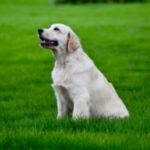
If you feel you have to choose between your best friend and your lawn, you are not alone.
Many homeowners face the familiar patches – either dark green and overgrown or else yellow and dead-looking; telling everyone that they own a canine. Is it possible to be able to have a green lawn and a dog?
Having a dog or more than one dog typically results in severely damage lawns through digging or other such wear and tear. And while dog feces are an eyesore and unpleasant to dispose of, dog urine is more damaging and can actually kill the grass.
### Symptoms:
– circular dead patches – consists of necrotic, dried out, yellow to brown, often encircled by a border of healthy, green grass
– small dogs releasing less urine may cause spots with very dark, taller growth grass
– burned spots may recover with regrowth depending upon amount of urine released, the type of grass, time of year, irrigation and rain concentrations
### Causes:
– Urine or uric acid – delivers large amounts of nitrogen and salts to a small area. The result is similar to spilling fertilizer in one spot.
– Dogs that squat to urinate cause more damage that dogs that raise their legs.
– Lawns that are fertilized regularly are typically worse
– Grasses like Kentucky Blue Grass and Bermuda Grass are more sensitive to higher nitrogen than rye or fescue
– Lawns that are stressed from drought or disease, or those that are recently sodded or seeded are more susceptible to lawn burn
### Solutions:
– Training a dog not to urinate on the lawn may be possible if alternate locations are available
– Watering the lawn or flooding the urine spot with large volumes of water immediately (or within 8 hours) after the act is the most effective way to prevent lawn burn. The water will wash off the salts and nitrogen from the foliage, diluting and leaching them into the ground
– Reduce the amount of fertilizer during the hot summer months, and apply a more balanced fertilizer such as a triple
– Amend the soil by adding Lime or Gypsum – this will improve the quality of the soil
– Topdress and overseed your lawn with rye or fescue
– If the lawns is severely damaged, apply topsoil and reseed or strip the sod, apply topsoil and resod the lawn
– Consult a vet to discuss diet of your dog
– Encourage your dog to drink more water and ensure it has access to fresh water at all times to lower the concentration in the urine
These tips will enable you to enjoy the companionship of a dog and keep your lawn beautiful, green and free of unsightly yellowish spots that are caused by high nitrogen levels in its urine.


